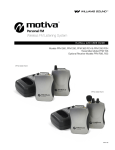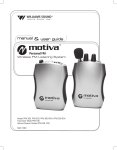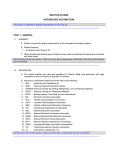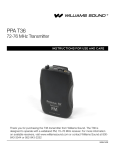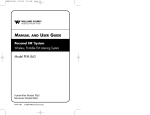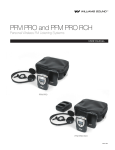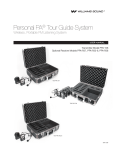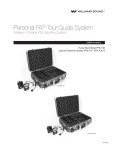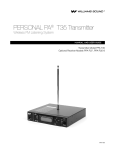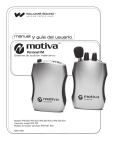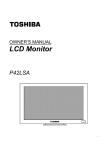Download Williams Sound PFM 330 RCH User guide
Transcript
manual & user guide ® Wireless FM Listening System Models PFM 360, PFM 330, PFM 360 RCH & PFM 330 RCH Transmitter Model PFM T36 Optional Receiver Models PFM R36, R33 MAN 146H Motiva® Personal FM System Models PFM 360, PFM 330, PFM 360 RCH & PFM 330 RCH Manual and User Guide System Overview System Components Safety Information Recycling Instructions Using the PFM T36 Transmitter Using the PFM R33 / 36 Receiver Belt Clip Installation Channel Selection Chart Battery Information Limited Warranty System Specifications Fm Receiver, Model PFM R33 Fm Receiver, Model PFM R36 Fm Transmitter, Model PFM T36 1 2 3 3 4 7 10 10 11 12 13 13 14 15 System Overview Thank you for purchasing a Motiva® Personal FM System from Williams Sound. Anyone needing auditory assistance to overcome background noise, reverberation, or distance from a sound source can benefit from a Personal FM System. Your PFM System has two principal parts: the Transmitter and the Receiver. Much like a miniature radio station, the Transmitter and microphone pick up the sounds you want to hear and broadcast them over an FM radio signal. The receiver and earphone are used to pick up the broadcast up to 150 feet away. To avoid difficulties, please read through these instructions as you begin using the system. Then save them for questions that arise as you continue to use your Williams Sound Personal FM System. If you have problems with the PFM system, don’t hesitate to call us toll-free at 1-800-843-3544. ... .... ... The speaker wears the belt-clip transmitter and a clip-on microphone. The speaker’s voice is broadcast as an FM radio signal over a distance of 150 feet. Listeners use the pocket receiver and earphones or headphones to hear the speaker’s voice directly, with reduced background noise. An optional neckloop telecoil coupler allows the system to be used with telecoil (T-switch) equipped hearing aids. 1 System Components Belt Clip Transmitter (PFM T36) with removable Belt Clip Lavalier microphone (MIC 090) Mini earphone (EAR 013) Stereo auxiliary input cable (WCA 087) System Carry Case (CCS 043) Screwdriver (SDF 002) Instructions (MAN 146) PFM System 330 Only: Personal FM Receiver (PFM R33) (4) AA Alkaline non-rechargeable batteries (BAT 001) PFM System 360 Only: Personal FM Receiver (PFM R36) Environmental Plug-mount Microphone (MIC 014) (4) AA Alkaline non-rechargeable batteries (BAT 001) PFM System 330 RCH Only: Personal FM Receiver (PFM R33) (4) AA NiMH rechargeable batteries (BAT 026) Drop-in Charger (CHG 3502) PFM System 360 RCH Only: Personal FM Receiver (PFM R36) Environmental Plug-mount Microphone (MIC 014) (4) AA NiMH rechargeable batteries (BAT 026) Drop-in Charger (CHG 3502) T36 2 R36 R33 Safety Information Hearing Safety CAUTION! This product is designed to amplify sounds to a high volume level which could potentially cause hearing damage if used improperly. To protect your hearing and the hearing of others: 1. Turn the volume down before putting on the earphone or headphone, and then adjust the volume to a comfortable level. 2. Set the volume level at the minimum setting that you need to hear. 3. If you experience feedback (a squealing or howling sound), reduce the volume setting and move the microphone away from the earphone or headphone. 4. Do not allow children or other unauthorized persons to have access to this product. Battery Safety CAUTION! This product may be supplied with alkaline batteries. Do not attempt to recharge alkaline batteries, which may explode, release dangerous chemicals, cause burns, or other serious harm to the user or product. Medical Device Safety CAUTION! 1. Before using this product with an implantable or other medical device, consult your physician or the manufacturer of your implantable or other medical device. 2. If you have a pacemaker or other medical device, make sure that you are using this product in accordance with safety guidelines established by your physician or the implantable device manufacturer. Recycling Instructions Battery Safety and Disposal Help Williams Sound protect the environment! Please take time to dispose of your equipment properly. Please do NOT dispose of batteries in the household trash. Please take the batteries to a retail or community collection point for recycling. Product Recycling: Please do NOT dispose of your Williams Sound equipment in the household trash. Please take the equipment to an electronics recycling center or return the product to the factory for proper disposal. 3 Using the PFM T36 Transmitter IMPORTANT: If Alkaline (nonrechargeable) batteries are being installed, slide the battery selection switch in the battery compartment to the “Alkaline” position. See FIG 1 below. If installing NiMH (or rechargeable) batteries, slide the battery selection switch to the “NiMH” position. FIG. 1: Battery Selection Switch 2:1 1:1 - Gain + - AUX + Comp CH Lock – AA + + AA – Auxiliary Power On/Off/Mute Channel Input batteries must be charged 1. Install two (2) AA batteries. Note: rechargeable before use. Selector See Battery Information on page 11. 2. Plug the microphone cord into the “Mic Jack” ( ) on top of the transmitter. Note: The microphone with 39 inch cord MUST be used with the Transmitter. Auxiliary Input Onusing Indicator 3. Optionally, plug in a desired audio source suchMic as Jack a CD or MP3Power player the “Auxiliary Input” jack (WCA 087 stereo auxiliary input cable included). If the microphone and an auxiliary source are used together, the audio will be mixed. If only the auxiliary source is desired, the microphone can be muted. Do not remove the microphone from the “Mic Jack” as the microphone’s cable is also the antenna! Powertransmitting On/Off/Mute Channel Selector 4. Turn the unit on: press and hold the “ON/OFF/MUTE” button for three seconds. The “Power On” indicator ( ) should illuminate green. Mic Jack 5. Select the desired operating frequency. Use the “Channel Selector” knob to select any of the 16 available channels on 72-76 MHz. Refer to the channel selection chart (FIG 9, Page 10). Make sure the receiver being used is operating on the same frequency as the T36 transmitter. Power On Indicator FIG. 2: PFM T36 User Controls Auxiliary Input Power On/Off/Mute Mic Jack Channel Selector Power On Indicator 6. Place the transmitter in a pocket, or clip it onto a belt or waistband (See “BELT CLIP INSTALLATION”, page 10). 4 7. Lapel clip microphones should be attached to a collar or lapel, as close to the speaker’s mouth as practical. If using an optional headset microphone, position the mic as close to the side of the mouth as possible without touching the mouth See FIG 3. FIG. 3: Lapel Microphone Placement Yes Yes No 8. To mute the microphone, press the “ON/OFF/MUTE” button momentarily. The “ON/OFF/MUTE” button will flash red. To unmute the microphone, press the “ON/OFF/MUTE” button momentarily again. IMPORTANT: When the PFM T36 transmitter is not being used, remember to turn the unit OFF by pressing and holding the “ON/OFF/MUTE” button for three seconds. The Power On indicator will not be lit. FIG. 4: Configuration Controls 2:1 1:1 - Gain + 1 - AUX + Comp CH Lock – AA + + AA – 2 1. Gain Control 2. Auxiliary Input Level 3 4 3. Compression Selector 4. Channel Lock GAIN CONTROL The gain control can be used to adjust the volume level on both the microphone and auxiliary input. To adjust the volume level, open the battery door and locate the Gain Control (see FIG 4). Use the supplied small screwdriver and rotate to increase “+” or decrease “-” the gain. 5 AUXILIARY INPUT LEVEL The auxiliary input level can be used to adjust the auxiliary input level only. To adjust, open the battery door and locate the Auxiliary Input Level (see FIG 4). Use the supplied small screwdriver and rotate to increase “+” or decrease “-” the input level. Note: When using an auxiliary audio source, if the “Aux Input Level” is set too high, there can be increased audio distortion and decreased battery life. Note: Microphone cable serves as the transmitting antenna; therefore must remain plugged in during Aux cable use. COMPRESSION SELECTOR By default, the PFM T36 compression is set to “Off” for normal operation, or “1:1” compression. For hearing assistance applications, the compression selector can be set to “On” for “2:1” compression. To change this setting, open the battery door and locate the Compression Selector (FIG 4). To turn on compression, use the supplied small screwdriver and slide the “Comp” switch to the position marked “2:1”. To turn off compression, slide the “Comp” switch to the position marked “1:1”. CHANNEL LOCK By default, the PFM T36 channels are unlocked to allow the user to change frequencies as needed. If desired, channels can be locked to prevent users from changing the channels. Note: The Channel Lock only locks the electronic frequency; it does not physically lock the channel selection knob. To lock or unlock channels, open the battery door and locate the Channel Lock (FIG 4). To lock the current channel while the unit is on, slide the “CH Lock” switch to the position 2:1 marked ( ). To unlock the 2:1 channels, use the supplied small screwdriver and slide the “CH Lock” switch1:1to the position 1:1marked ( ). - Gain + - AUX + - Gain Comp + LOW BATTERY INDICATOR The “Power On” indicator (see FIG 2) will flash to indicate low battery. – –AA CH Lock - AUX + Comp AA+ BATTERY LIFE EXPECTANCY AFTER LOW BATTERY SIGNAL TransmitterReceiver + Alkaline 90 min.Alkaline 60 min. AA– +AA NiMH 15 min.NiMH15 min. 6 CH Lock + – Using the PFM R33 / R36 Receiver IMPORTANT: If Alkaline (nonrechargeable) batteries are being installed, slide the battery selection switch in the battery compartment to the “Alkaline” position. See FIG 5 below. If installing NiMH (or rechargeable) batteries, slide the battery selection switch to the “NiMH” position. FIG. 5: Battery Selection Switch / ConFIGuration Controls Battery Selection Switch 1 1. Tone Control 2 3 2. Channel Selector 3. Max Gain Control 1. Install two (2) AA batteries. Note: rechargeable batteries must be charged before use. See Battery Information on page 11. 2. (Applies only to PFM R36) Insert the small plug mount microphone (MIC 014) into the “Mic Jack” ( ) on the top of the receiver. See FIG 7 below. Note: The MIC 014 cannot be used with the transmitter. FIG. 6: PFM R33 Top View FIG. 7: PFM R36 Top View 3. Plug the earphone or headphone into the “Headphone Jack” ( ) on top of the receiver. See FIG 6 / FIG 7. Place the headphones on your head or earphone in your ear. 4. Turn the power on by rotating the “On/Off/FM Volume” knob clockwise. The “Power On Indicator” ( ) should illuminate green. 5. Select the desired operating frequency. Locate the “Channel Selector” inside the battery door (See FIG. 5). Use the supplied small screwdriver to rotate the switch to the desired channel (See FIG. 9, Page 10: Channel Selection Chart). 7 6. Adjust the receiver tone control to your needs. Locate the tone control inside the battery door. Use the supplied small screwdriver to rotate the “Tone Control”. A low setting (fully counter-clockwise “-”) emphasizes lower frequencies. A medium setting (rotated to a vertical position) has some low frequency cut. A high setting (fully clockwise “+”) maximizes low frequency cut and emphasizes higher frequencies. Note: the earphone cord is also the receiving antenna. Do not bunch up the cord or wrap it around the receiver. For best reception, the cord should hang as straight as possible. 7. Clip the receiver onto a belt or waistband, or slip it into a pocket (see Belt Clip Installation, page 10). 8. Check that the “FM Indicator” is illuminated yellow. Turn the “On/Off/FM Volume” knob to adjust the volume to a comfortable listening level. IMPORTANT: Make sure the receiver is turned OFF when not in use. Turn the “FM Volume” knob completely counter-clockwise. It should “click” and the “Power On” indicator should turn off. ADJUSTING THE R36 VOLUME CONTROLS: A. Adjust the left control, “On/Off/FM Volume”, to a comfortable listening level. Check that the “FM Indicator” is illuminated yellow. Turn the volume knob clockwise until you are able to hear audio from the transmitter. B. Adjust the right control, “Mic”, volume second, turning it clockwise until you can hear sounds picked up by the plug mount microphone. C. Adjust the “Mic” and “On/Off/FM Volume” controls for a comfortable mix of FM and ambient sounds. MAX GAIN CONTROL Adjust the “Max Gain” if you have sensitive hearing due to hearing loss. This feature limits the maximum volume output by the receiver in case of sudden bursts of sound. To adjust the “Max Gain”, use the supplied small screwdriver and turn it to a comfortable maximum volume level. In a fully clockwise position the maximum volume is not reduced. In a fully counter-clockwise position, the maximum volume is reduced by 17 to 20 dB. LOW BATTERY INDICATOR The “Power On” indicator (see FIG. 6/7, page 7) will flash to indicate low battery. The listener may continue to use until the unit stops operating, then replace or recharge the batteries. 8 BELT CLIP INSTALLATION To Install: Position the belt clip on the rear of the device as shown in FIG 8A. Turn the belt clip 180° left or right as shown in FIG 8B. The belt clip is now installed and ready for use. To Remove: Turn the belt clip 180° so the open end of the clip points to the top of the unit as shown in FIG 8A. Gently pull the belt clip away from the unit to remove. FIG. 8A FIG. 8B CHANNEL SELECTION CHART For convenience, the PFM T36, PFM R36, and PFM R33 all use the same frequencies in the same positions on their channel selection switches. FIG. 9 9 BATTERY INFORMATION Open the battery compartment by pressing and lifting the tab on the back of the device with your finger. To remove depleted batteries, pull up on the fabric strip. Press the new batteries into place over the fabric strip. Be sure to observe proper polarity (+/-). Damage due to improper battery installation may void the warranty on the product. Close the battery door. The “Power On” LED on top of the device will flash when the batteries are getting low; you may continue to use the unit until it stops operating, then replace or recharge batteries. The receiver or transmitter can use two (2) Alkaline AA batteries (BAT 001) or two (2) AA rechargeable batteries (BAT 026). Note: The BAT 026 provides longer life than other rechargeable batteries. For best product performance, do not substitute other rechargeable batteries and chargers. PFM R33/R36 EXPECTED BATTERY LIFE Alkaline batteries (BAT 001): 21 hours Rechargeable NiMH Batteries (BAT 026): 17 hours Minimum14 hour recharge time. PFM T36 EXPECTED BATTERY LIFE Alkaline batteries (BAT 001): 30 hours Rechargeable NiMH Batteries (BAT 026): 20 hours Minimum14 hour recharge time. Refer to page 6 for battery life expectancy after low battery signal. If the Motiva™ System you’ve purchased is equipped with rechargeable batteries, up to 2 units can be charged with the CHG 3502 that comes with the system. Up to 12 units can be charged at one time in the optional CHG 3512 or CHG 3512 PRO multi-charger. For ordering information, please contact Williams Sound at 800-843-3544. Additional information on the CHG 3502 is listed below. WARNING: Use this charger with Williams Sound NiMH rechargeable batteries only. DO NOT use non-rechargeable batteries, such as alkaline and carbon zinc, which may heat up and burst, causing possible injury and damage to the equipment. Before inserting the receiver or transmitter into the charger, be sure each unit has NiMH rechargeable batteries installed. Also, check to make sure the switch setting in the receiver or transmitter battery compartment indicates the “NiMH” setting. FIG. 10A Receiver or Transmitter Charging LED Indicator 1. Plug the CHG 3502 power supply into the AC wall outlet. Plug the power connector into the rear of the CHG 3502 unit (FIG. 10B). 2. Insert the receiver or transmitter into the charging slot as illustrated in FIG. 10A. The unit(s) must be placed in the charger facing forward to make contact with charger contacts. A red LED indicator will illuminate when the batteries are being charged (FIG 10A.). • You may charge up to 2 receiver / transmitter units per CHG 3502 charger. FIG. 10B • It will take approximately 16 hours to fully charge the batteries. NOTE: It is safe to leave the receiver/transmitter units in the charger, even after the batteries are fully charged. CHG 3502 Rear View 10 AC Power Connection HAVING DIFFICULTIES? Motiva PFM System Troubleshooting Static audio in the receiver – • Make sure the Transmitter and Receiver are set to the same channel. • Make sure you are using fresh or fully recharged batteries. • Microphone cord and earphone cord serve as transmitting and receiving antennas. Try to keep the antennas in a vertical orientation. The microphone with 39inch cord MUST be used with the Transmitter. • Only one Transmitter can be used in the same area at one time. If another Transmitter is in use it must be set to a different channel. • You may be out of range for the system. Move closer to the Transmitter. No sound in receiver – • Check batteries are good. • Check the batteries are installed correctly. • Make sure earphone is plugged into the earphone jack. Charger light not coming on – • Make sure the power supply is plugged in. • Make sure rechargeable batteries are installed into the Transmitter and Receiver and that the ALK/NiMH selector inside the battery compartments is switched to NiMH. • The Transmitter and Receiver should be turned OFF while charging. 11 LIMITED WARRANTY Williams Sound products are engineered, designed and manufactured under carefully controlled conditions to provide you with many years of reliable service. Williams Sound warrants the PFM T36 transmitter, PFM R36 and PFM R33 receivers against defects in materials and workmanship for FIVE (5) years. During the first five years from the purchase date, we will promptly repair or replace. Microphones, earphones, headphones, batteries, cables, carry cases, and all other accessory products carry a 90-day warranty. Chargers carry a one year warranty. WILLIAMS SOUND HAS NO CONTROL OVER THE CONDITIONS UNDER WHICH THIS PRODUCT IS USED. WILLIAMS SOUND, THEREFORE, DISCLAIMS ALL WARRANTIES NOT SET FORTH ABOVE, BOTH EXPRESS AND IMPLIED, WITH RESPECT TO THE DEVICES, INCLUDING BUT NOT LIMITED TO, ANY IMPLIED WARRANTY OF MERCHANTABILITY OR FITNESS FOR A PARTICULAR PURPOSE. WILLIAMS SOUND SHALL NOT BE LIABLE TO ANY PERSON OR ENTITY FOR ANY MEDICAL EXPENSES OR ANY DIRECT, INCIDENTAL OR CONSEQUENTIAL DAMAGES CAUSED BY ANY USE, DEFECT, FAILURE OR MALFUNCTION OF THE PRODUCT, WHETHER A CLAIM FOR SUCH DAMAGES IS BASED UPON WARRANTY, CONTRACT, TORT OR OTHERWISE. THE SOLE REMEDY FOR ANY DEFECT, FAILURE OR MALFUNCTION OF THE PRODUCT IS REPLACEMENT OF THE PRODUCT. NO PERSON HAS ANY AUTHORITY TO BIND WILLIAMS SOUND TO ANY REPRESENTATION OR WARRANTY WITH RESPECT TO THE DEVICES. UNAUTHORIZED REPAIRS OR MODIFICATIONS WILL VOID THE WARRANTY. The exclusions and limitations set out above are not intended to, and should not be construed so as to contravene mandatory provisions of applicable law. If any part or term of this Disclaimer of Warranty is held to be illegal, unenforceable or in conflict with applicable law by a court of competent jurisdiction, the validity of the remaining portions of this Disclaimer of Warranty shall not be affected, and all rights and obligations shall be construed and enforced as if this Limited Warranty did not contain the particular part or term held to be invalid. If you experience difficulty with your system, call Toll-Free for Customer Assistance: 1-800-843-3544 (U.S.A.) or 1-952-943-2252 (Outside the U.S.A.) If it is necessary to return the system for service, your Customer Service Representative will give you a Return Authorization Number (RA) and shipping instructions. Pack the system carefully and send it to: Williams Sound Attn: Repair Dept. 10300 Valley View Rd. Eden Prairie, MN 55344 12 SYSTEM SPECIFICATIONS FM RECEIVER, MODEL PFM R33 Dimensions: 4.6” L x 2.8” W x 1.1” H (116 mm x 71 mm x 28 mm) Weight: 3.4 oz (96 g), no batteries Color:Titanium Housing Material: Shatter-resistant PC/ABS plastic Battery Type: Two (2) AA 1.5 V non-rechargeable Alkaline batteries (BAT 001), 70 mA nominal current drain, approximately 21 hours life, or Two (2) AA 1.5 V NiMH rechargeable batteries (BAT 026), 70 mA nominal current drain, approximately 17 hours per charge, recharges in 14–16 hours, uses CHG 3502 or CHG 3512 Charger. Operating Frequencies: Selectable, 16 channels, 72.1 – 75.9 MHz* FM Deviation: ± 75 kHz max synthesized, crystal reference, PLL Sensitivity: 2.5 µV at 12 dB Sinad with Squelch defeated. Freq Response: 200 Hz to 12 kHz, -3 dB Signal-to-Noise Ratio: 62 dB at 100µV Receive Antenna: Integral with earphone/headphone cord External Controls: Volume: rotary on/off/volume Internal Controls Tone: rotary tone control (Inside battery compartment) Channel: 16 position rotary switch Max Gain: rotary adjust Indicators: On/off/low battery and FM LED’s Audio Output: Stereo jack produces 30 mW, max at 16 Ohm, can be reduced by internal Max Gain control up to 17 dB Approvals/Directives: FCC, Industry Canada, RoHS, WEEE Warranty: 5 years, parts and labor (90 days on accessories) Statement for compliance to “RSS-Gen Issue 2 June 2007” for Industry Canada and part 15 of the FCC Rules: Operation is subject to the following two conditions: (1) this device may not cause interference, and (2) this device must accept any interference, including interference that may cause undesired operation of the device. *DISCLAIMER: FCC RULES LIMIT USE OF THIS EQUIPMENT TO AUDITORY ASSISTANCE. NOTE: SPECIFICATIONS SUBJECT TO CHANGE WITHOUT NOTICE. 13 SYSTEM SPECIFICATIONS FM RECEIVER, MODEL PFM R36 Dimensions: 4.6” L x 2.8” W x 1.1” H (116 mm x 71 mm x 28 mm) Weight: 3.4 oz (96 g), no batteries Color:Titanium Housing Material: Shatter-resistant PC/ABS plastic Battery Type: Two (2) AA 1.5 V non-rechargeable Alkaline batteries (BAT 001), 70 mA nominal current drain, approximately 21 hours life, or Two (2) AA 1.5 V NiMH rechargeable batteries (BAT 026), 70 mA nominal current drain, approximately 17 hours per charge, recharges in 14–16 hours, uses CHG 3502 or CHG 3512 Charger. Operating Frequencies: Selectable, 16 channels, 72.1 – 75.9 MHz* FM Deviation: ± 75 kHz max synthesized, crystal reference, PLL Sensitivity: 2.5 µV at 12 dB Sinad with Squelch defeated. Freq Response: 200 Hz to 12 kHz, -3 dB Signal-to-Noise Ratio: 62 dB at 100 µV Receive Antenna: Integral with earphone/headphone cord External Controls: Volume: rotary on/off/volume Microphone Volume: rotary control Internal Controls Tone: rotary tone control (Inside battery compartment) Channel: 16 position rotary switch Max Gain: rotary adjust Indicators: On/off/low battery and FM LED’s Mic Input: 3.5 mm mono phone jack with electret microphone bias, external adjustable gain with 50 dB range Audio Output: Stereo jack produces 30 mW, max at 16 Ohm Ω, can be reduced by internal Max Gain control up to 17 dB Approvals/Directives: FCC, Industry Canada, RoHS, WEEE Warranty: 5 years, parts and labor (90 days on accessories) Statement for compliance to “RSS-Gen Issue 2 June 2007” for Industry Canada and part 15 of the FCC Rules: Operation is subject to the following two conditions: (1) this device may not cause interference, and (2) this device must accept any interference, including interference that may cause undesired operation of the device. *DISCLAIMER: FCC RULES LIMIT USE OF THIS EQUIPMENT TO AUDITORY ASSISTANCE. NOTE: SPECIFICATIONS SUBJECT TO CHANGE WITHOUT NOTICE. 14 SYSTEM SPECIFICATIONS FM TRANSMITTER, MODEL PFM T36 Dimensions: 4.1” L x 2.8” W x 1.1” H (104 mm x 71 mm x 28 mm) Weight: 2.6 oz (74 g), no batteries Color:Titanium Housing Material: Shatter-resistant PC/ABS plastic Battery Type: Two (2) AA 1.5 V non-rechargeable Alkaline batteries (BAT 001), 70 mA nominal current drain, 30 hours approx. life or Two (2) AA 1.5 V NiMH rechargeable batteries (BAT 026), 70 mA nominal current drain, 20 hours per charge approx., recharges in 14–16 hours, uses CHG 3502 or CHG 3512 Charger Operating Freq’s: Selectable, 16 channels, 72.1 – 75.9 MHz* (channels 1-8 correspond with R35-8 receiver channels) Stability: ± .005%, frequency synthesized, crystal reference, PLL Modulation: Wide-band FM, 75 kHz pk, 75 μS pre-emphasis RF Output: 80 mV/m at 3 m (max. allowed by FCC rules) Freq Response: 200 Hz to 13 kHz, ± 3 dB at 1% max. THD Signal-to-Noise Ratio: 65 dB (typical) transmitted Transmit Antenna: Integral with microphone cord Microphone: Electret type, 3.5 mm mono phone plug External Controls: Momentary push button: push and hold 3 seconds for power On/Off, push and release for microphone mute On/Off; Rotary sixteen channel switch (with internal channel lock switch) Mic Input: 3.5 mm mono phone jack with electret mic bias, internal adjustable gain with 25 dB range Aux Input: 2.5 mm stereo phone jack, internal adjustable gain with 60 dB range Audio Compression: 1:1 or 2:1 ratio selected with internal slide switch Compatible Receivers: PFM R31, PFM R32, PFM R33, PFM R36, PPA R37, PPA R35-8, PPA R1600 Approvals/Directives: FCC, Industry Canada, RoHS, WEEE Warranty: 5 years, parts and labor (90 days on accessories) Statement for compliance to “RSS-Gen Issue 2 June 2007” for Industry Canada and part 15 of the FCC Rules: Operation is subject to the following two conditions: (1) this device may not cause interference, and (2) this device must accept any interference, including interference that may cause undesired operation of the device. *DISCLAIMER: FCC RULES LIMIT USE OF THIS EQUIPMENT TO AUDITORY ASSISTANCE. NOTE: SPECIFICATIONS SUBJECT TO CHANGE WITHOUT NOTICE. 15 16 17 10300 Valley View Rd., Eden Prairie, MN 55344 U.S.A. 800.843.3544 • 952.943.2252 • Fax 952.943.2174 williamssound.com © 2011 Williams Sound, LLC Man 146H





















